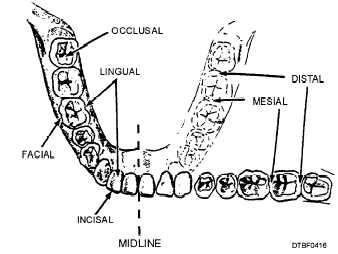the full name of the tooth.
Therefore, you would identify a specific second molar in the following manner: right mandibular second molar. Although there are four second molars in the mouth, naming the quadrant (right mandibular) narrows the field down to one specific second molar.
UNIVERSAL NUMBERING SYSTEM
The Universal Numbering System is a simplified method of identifying teeth that is approved by the American Dental Association and used by the armed services. This method employs numbers with each tooth designated by a separate number from 1 to 32. Standard Dental Chart. When charting, you would refer to a tooth by number rather than the name. Instead of referring to the right maxillary third molar, you would refer to tooth No. 1. Each permanent tooth Figure 4-15 illustrates the numbering system used on a has its own number.
The 20 primary teeth are identified on the dental chart by the use of capital letters A to T. Lettering starts with upper right second primary molar (tooth A, located above the root of the maxillary second premolar); goes across to the upper left second primary molar (tooth J); down to the lower left second primary molar (tooth K), and across to the lower right second primary molar. Please note that the letters of the primary second and first molars appear above the roots of the permanent teeth of the second and first premolars.
When using a dental form, remember that the right and left sides are reversed. The right side of the patient's mouth appears on the left side of the dental chart; the left side of the patient's mouth appears on the right side. This arrangement is necessary because the dental officer and the assistant see the sides reversed when they look into a patient's mouth. Full instructions for using dental forms, will be provided in Dental Technician, Volume 2, NAVEDTRA 12573, chapter 2, “Oral Examination.”
SURFACES OF THE TEETH
Not only must the assistant be able to name and locate a tooth, but must also be able to identify the different types of tooth surfaces. Figure 4-16 shows a number of different surfaces of the teeth.
Facial, Mesial, Distal, Lingual, and Incisal Surfaces
The facial is the surface of a tooth that "faces" toward the lips or cheeks. When there is a requirement to be more specific, terms like labial and buccal are used. The labial is the surface of an anterior tooth that faces toward the lips. The buccal is the surface of a posterior tooth that faces toward the cheek. The mesial is the proximal surface closest to the midline of the arch.
The distal is the opposite of mesial. The distal is the proximal surface oriented away from the midline of the arch.
The lingual is the surface of an anterior or posterior tooth that faces toward the tongue. Incisal edges are narrow cutting edges found only in the anterior teeth (incisors). Incisors have one incisal edge.

Figure 4-16. - Surfaces of the teeth.
Continue Reading